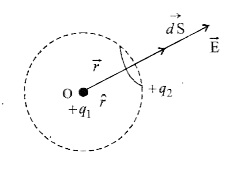Deduce Coulomb's law from Gauss's theorem.
Consider two points charges q1andq2 separated by a distance r. Draw a sphere of radius r with O as the centre where O is the position of charge q1.
Now consider a small area element of area ds over the sphere The angle between −→dS and electric field →E is zero.
i.e. θ=0
According to Gauss.s.s Theorem
∮→E.−→dS=qɛ0
∮EdScosθ=qɛ0
∮SEdScos0∘=q1ɛ0
∮SEdS=q1ɛ0
Since ɛE is constant on all points of Gaussian.s surface.
∴ ⎛⎜⎝E∮SdS=q1ɛ0⎞⎟⎠
But ∮SdS=4πr2
∴ E×4πr2=q1ɛ0⇒E=14πɛ0q1r2
This is the value of electric field intensity at the position of q2.
Thus the force experienced by q2 is given be
F=q0E
=q0×14πɛ0q1r2
∴ F=14πɛ0q1q2r2
This is the mathematical form of Coulomb.s Law.

Similar Questions
Knowledge Check
- Question 1 - Select One
Gauss's theorem is
A∮→B⋅d→s=0B∮→B⋅d→s=Qε0C∮→B⋅d→s=μ0iD∮→B⋅d→s=μ0i
Define unit pole from Coulomb's law of magnetism.
View SolutionObtain the formula for the electric field due to a long thin wire of uniform linear charge density λ without using Gauss's law. [Hint. use Coulomb's law directly and evaluate the necessary integral].
View SolutionObtain the formula for the electric field due to a long thin wire of uniform linear charge density λ without using Gauss's law. [Hint.use Coulomb's law directly and evaluate the necessary integral ].
View SolutionExamples on Flux || Flux Due to a Point Charge || Gauss's Theorem || Application OF Gauss's Theorem
View SolutionCharging By Induction |Coulomb's Law |Questions Based On Coulomb's Law |Vector From Of Coulomb's Law
View SolutionWhat is the Importance of expressing coulomb's law in vector from ?
View SolutionIf Coulomb's law involved 1r3 instead of 1r2, would Gauss's law still be true?
View Solution

